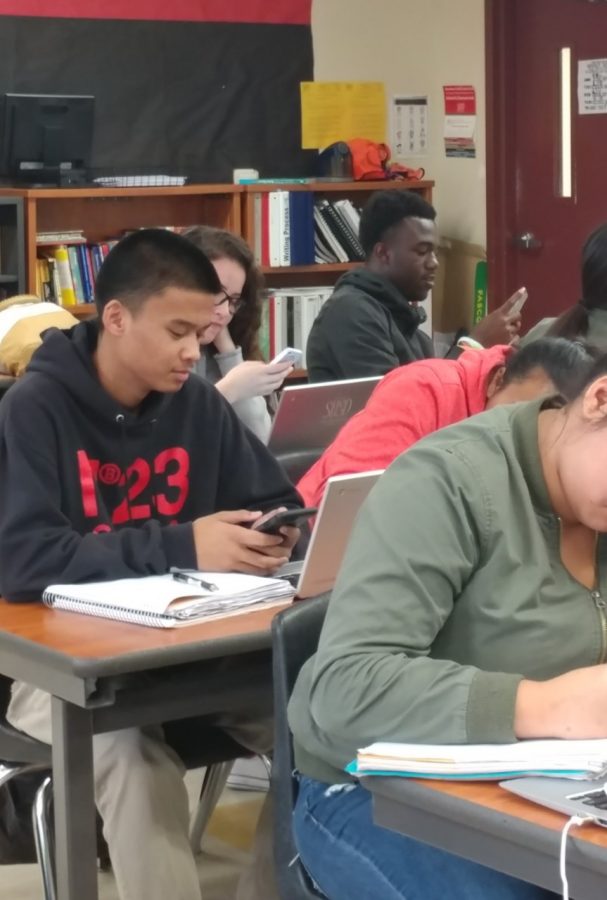Cellphone Use in the Classroom
Before the twenty first century people used to write letters to communicate or send postcards to show others where they’ve been. Today we have cell phones and social media to communicate and socialize. Of course cell phones have definitely made our lives easier, but they have also made it too easy to be distracted. For example, just think of a moment when your phone distracted you from what you were doing or maybe someone was talking to you and you just weren’t paying attention. It has happened and it continues to happen in schools all other the United States. From elementary to high schools, it’s very common to see students holding and looking down at their cell phone. Although this doesn’t seem like a big enough deal to be worried about, students are using crucial learning time in the classroom to play on their cell phones.
Teachers have reported seeing their students using their cell phones while they are trying to teach. Things like social media such as facebook, twitter, instagram, snapchat, kik, gaming and texting, are becoming more popular amongst young children and teens. According to studies taken last year, 88% of American teens ages 12-17 years old, have access to a smartphone. Inside every classroom there is at least five or more students that have a cell in their pocket. Now, these numbers can easily change especially with new technology coming out each year. Not only can students use social media or games during class, but they can also use their cell phones to cheat for a test or homework assignment. Nowadays everything can be found on the internet. If you are curious about a certain thing you can easily go to the nearest source and search it on google. Studies have shown that 92% of teens go online daily with or without the use of a cell phone.
Some may also wonder about what the parents of these teens feel. At least 50% of American parents say that their teenagers are addicted to their phones. Addiction is a very strong word and is the best way to describe what is actually going on. Addiction is when something or someone is dependent on a substance, thing or activity. Are some teens really addicted to their cell phones? Yes, they are. Since the sixth grade, I’ve seen that social media and cell phones are what made you “popular” and that seems to be the same thing going on today. In my household everyone has a cell phone. I particularly use my phone for watching videos when I’m bored. Sometimes I notice that I would be lazy and not what to move from my phone because I just want to keep watching. By the time I realize that I haven’t done my chores and my homework it’s nine o’clock and I need to go to bed for the next school day. The same thing has happened to my brothers multiple times and still happens quite often. If addiction is a word only used when someone has a serious problem with drugs or alcohol, then how would you describe a student using his or her cell phone from the time they wake up to the time they go to bed? Addiction is something that you cannot control, so a distraction like cell phones is a bad thing to bring to school.
Is cell phone addiction a real thing? Yes, cell phone addiction is a real thing and there are even websites that people can use to get help or treatment. One of these websites is called PsychGuides.com. This website has information on almost every psychological problem
people may have. According to this website symptoms include; excessive use, job or grades at risk, tolerance and withdrawal. I have seen all these symptoms in multiple students I’ve had class with. Here at Chavez cell phones in class is a big deal and some teachers are more strict on the subject than others. Two well known teachers on campus handle this cell phone issue quite well, in my opinion. One of the teacher was Mr. Maria who says, “ it causes loss of engagement in class and effort.” “If I see them using it, it will be taken away ‘til the end of class and if they continue to use it, it will be taken until the end of the day and a parent has to pick it up.” I asked Mr. Maria how he deals with students who use their cell phones during class. His response was, “I talk to them and try to understand why they are using their cell phone.” In Mr. Maria’s classes about 20% of his students use their phone in class per day, 16% of them are failing and 80% are passing. Another teacher who I spoke with was Ms. Hughes. “The use of cell phones decreases their attention span, they miss important information in class and ultimately lowers their grade.” “If they’re a repeating offender they get sent out,” she said. On average, 3-4 students use their cell phones in Ms. Hughes’s class per day, 90% of her students are passing and none of those students use their phones during class. While some think cell phones aren’t that big of an issue, these numbers show that cell phone use in class can decrease a student’s grade. Teachers should stress this issue more just like Mr. Maria and Ms. Hughes do. In conclusion, students should pay attention in class and let nothing distract them from their future.






